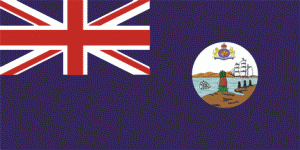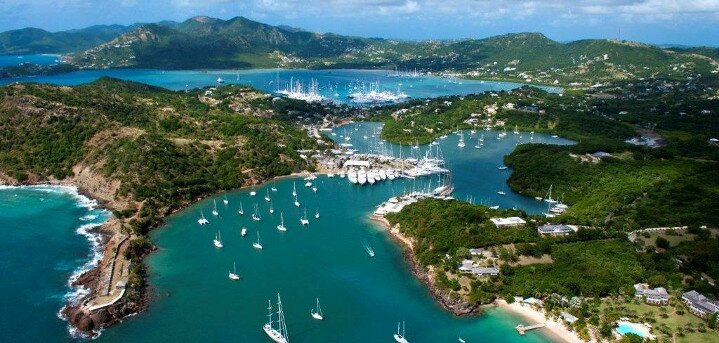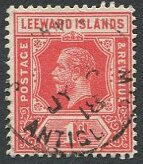
Leeward Islands
Quick reference
General issues: British federal colony 1890-1956
Country name on general issues: Leeward Islands
Currency: 1 Pound = 20 Shilling, 1 Shilling = 12 Pence 1890-1951, 1 Dollar = 100 Cent 1951-1956
Population: with Dominica 121 000 in 1900, without Dominica 127 000 in 1956
Political history Leeward Islands
Gaining possession
The Leeward Islands are located in the Caribbean. Geographically the Leewards Islands are the northern part of the Lesser Antilles – the southern part being the Windward Islands. Just prior to colonization, most of the Leeward Islands were inhabited by the Amerindian Carib people – some of the islands were uninhabited. The first European to sight the islands was Christopher Columbus on his second voyage to the Americas in 1493. On this voyage, Columbus first arrived at Dominica, then sailed north to explore the Leeward Islands, and, finally, west to explore the Greater Antilles. The islands were claimed for Spain, but the Spanish did not settle them. In the 17th century several other nations laid claim to parts of the Leeward Islands. They included the British, the Danish, the Dutch, and the French. The islands would go back and forth between these competing nations, until, by the early 19th century, sovereignty over the islands had been divided among them. Thus, the British gained sovereignty over the following islands:
- Antigua – with Barbuda as dependency
- Dominica
- Montserrat
- Nevis
- Saint Kitts – with Anguilla as dependency
- the Virgin Islands
From loose association to centralized federation
The British grouped their possessions in the Leeward Islands as the Leeward Islands colony in 1671. Antigua became the seat of the governor of the Leeward Islands. At the time, the Leeward Islands colony constituted a loose association, with the constituent parts each having their own governors, parliaments and legislation. The Leeward Islands would thus be administered until 1871 – with a short interval, between 1816 and 1833, when the Leeward Islands were divided into two separate colonies. In 1871, the name was changed to the federal colony of the Leeward Islands. Not only was the name changed, the British also centralized the administration of the islands, by appointing one governor for the Leeward Islands, and imposing one set of legislation. The former colonies now became presidencies of the Leeward Islands. The attempt to amalgamate the islands into a unified political entity met with strong opposition from the constituent parts of the federation and proved only partially successful. Minor changes occurred in 1883, when Saint Kitts and Nevis were grouped together as the presidency of Saint Kitts & Nevis, and in 1940, when Dominica was transferred from the Leeward to the Windward Islands – the federation that grouped together the British possessions in the Windward Islands.

The English Harbour on Antigua. Once the base of the British Royal Navy fleet in the Caribbean, it is now the domain of yachts as shown on this picture during the Antigua Sailing Week.
The closing years and beyond
As part of the process of decolonization, the British, in the 1950’s, aimed at federating not only the Leeward Islands but all British possessions in the Caribbean. Thus, the Leeward Islands Federation was dissolved in 1956 and the West Indies Federation was established. The Leeward Islands became the Leeward Islands Territory, which was abolished in 1960. The presidencies of the Leeward Islands became separate colonies, that, as such, joined the West Indies Federation in 1958. The Virgin Islands opted to stay out of the West Indies Federation and became a separate colony in 1960.
While amalgamating the Leeward Islands had proved to be difficult, federating all British possessions proved impossible. The short lived West Indies Federation was dissolved in 1962. The constituent parts became separate colonies again that, in subsequent years, gained independence or decided to remain part of the United kingdom as, currently, British overseas possessions. Thus, Antigua & Barbuda and Saint Kitts & Nevis gained independence and Anguilla – seceded from Saint Kitts & Nevis, Montserrat, and the Virgin Islands became British overseas territories.
Economics and demographics
Economically, most of the Leeward Islands were developed as plantation colonies – sugar cane being the most important crop since the late 17th century. To man the plantations, slaves were brought to the islands, who eventually outnumbered the planters of European descent. Some of the islands – Nevis, Saint Kitts – came to rank among the wealthiest British colonies. The economies of the islands generally went into decline when, in the second part of the 19th century, sugar cane production became less profitable. In the 20th century many of the islands recovered, developing tourism and off shore financial services. The indigenous Caribs became extinct on the islands, with the exception of Dominica. Currently, the majority of the population is black.
Postal history Leeward Islands
The first stamps used in the Leeward Islands were the general issues of great Britain. These were used in a short period, between 1858 and 1868, when the post offices in the Leeward Islands were put under the authority of the London post office. Subsequently, prior to the first issues of the Leeward Islands, the presidencies of the Leeward Islands have all issued stamps from different dates as follows:
- Antigua from 1862
- Dominica from 1874
- Montserrat 1876
- Nevis from 1861
- Saint Kitts from 1870
- the Virgin Islands from 1866.
The Leeward Islands colony issued its first stamps in 1890, which superseded the issues of the presidencies. The issues of the Leeward Islands were used exclusively, until 1899, in the Virgin Islands and, until 1903, in the other presidencies. Since 1899 and 1903 respectively, the presidencies resumed issuing stamps that were used concurrent with the issues of the Leeward Islands. Saint Kitts and Nevis did not resume issuing stamps as they had merged into Saint Kitts & Nevis that now became the stamp issuing entity. The issues of the Leeward Island are mainly of designs common to the British colonies. Specific for the Leeward Islands is an issue in commemoration of the 60th anniversary of the reign of Queen Victoria – hand stamped overprints on the 1890 issue with the overprint reading ‘Sexagenary 1897’ and showing a ‘V.I.R.'[1]‘Victoria Imperatrix Regina’ or ‘Victoria Empress and Queen’ monogram. The Leeward Islands joined in a number of the omnibus issues for the British colonies. The issues of the Leeward Islands were withdrawn in 1956.
For an overview of the political and postal developments in the form of a diagram, please refer to the country diagram of the British Leeward Islands. For more details about the political and postal history of the constituent parts of the Leeward Islands, please refer to the profiles of these countries.
Album pages
← Previous page: JamaicaNext page: Martinique →



